Best Practice in Battery Energy Storage for Photovoltaic Systems in Low Voltage Distribution Network: A Case Study of Thailand Provincial Electricity Authority Network
Abstract
1. Introduction
1.1. Study Objective and Approach
1.2. Literature Review
2. Materials and Methods
2.1. PEA Network Components, Network Constraints, Loads and Solar PV Profiles
- Network components
- Network constraints
- Load and solar PV generation profiles
- Focus points of the grid network studies
2.2. Scenarios for the Simulation Studies Using the Model
2.3. Description of the Model—Bisection Method and Sizing Algorithm for Optimization of BESS
2.4. Description of the Simulation Studies
2.5. Limitation of the Simulation Studies
3. Results and Discussions
3.1. Scenario 1 (Summer/Weekends)
3.2. Scenario 2 (Summer/Weekdays)
3.3. Scenario 3 (Winter/Weekends)
3.4. Scenario 4 (Winter/Weekdays)
4. Conclusions
Author Contributions
Funding
Data Availability Statement
Acknowledgments
Conflicts of Interest
References
- International Renewable Energy Agency (IRENA). REmap: Roadmap for a Renewable Energy Future. 2016 Edition. Available online: http://www.irena.org/publications/2016/Mar/REmap-Roadmap-for-A-Renewable-Energy-Future-2016-Edition (accessed on 23 November 2021).
- International Renewable Energy Agency (IRENA). Renewable Power Generation Costs in 2020. Available online: https://www.irena.org/publications/2021/Jun/Renewable-Power-Costs-in-2020 (accessed on 23 November 2021).
- Department of Alternative Energy Development and Efficiency (DEDE). Thailand Alternative Energy Development Plan 2018–2037 (AEDP 2018). 2019. Available online: https://policy.asiapacificenergy.org/node/4351 (accessed on 10 December 2021). (In Thai)
- Department of Alternative Energy Development and Efficiency (DEDE). Thailand Alternative Energy Situation 2019. Available online: https://www.dede.go.th/download/stat63/Thailand%20Alternative%20Energy%20Situation%202019.pdf (accessed on 10 December 2021). (In Thai)
- European Association for Storage of Energy (EASE) and European Energy Research Alliance (EERA). European Energy Storage Technology Development Roadmap, 2017 Update. Available online: https://ease-storage.eu/wp-content/uploads/2017/10/EASE-EERA-Storage-Technology-Development-Roadmap-2017-HR.pdf (accessed on 10 November 2021).
- Wei, J.; Zhang, Y.; Wang, J.; Wu, L.; Zhao, P.; Jiang, Z. Decentralized Demand Management Based on Alternating Direction Method of Multipliers Algorithm for Industrial Park with CHP Units and Thermal Storage. J. Mod. Power Syst. Clean Energy 2022, 10, 120–130. [Google Scholar] [CrossRef]
- Habib, A.H.; Disfani, V.R.; Kleissl, J.; de Callafon, R.A. Optimal energy storage sizing and residential load scheduling to improve reliability in islanded operation of distribution grids. In Proceedings of the 2017 American Control Conference (ACC), Seattle, WA, USA, 24–26 May 2017; pp. 3974–3979. [Google Scholar] [CrossRef]
- Dominguez, O.D.M.; Kasmaei, M.P.; Lavorato, M.; Mantovani, J.R.S. Optimal siting and sizing of renewable energy sources, storage devices, and reactive support devices to obtain a sustainable electrical distribution system. Energy Syst. 2018, 9, 529–550. [Google Scholar] [CrossRef]
- Babacan, O.; Torre, W.; Kleissl, J. Siting and sizing of distributed energy storage to mitigate voltage impact by solar PV in distribution systems. Sol. Energy 2017, 146, 199–208. [Google Scholar] [CrossRef]
- Ma, Y.; Azuatalam, D.; Power, T.; Chapman, A.C.; Verbic, G. A novel probabilistic framework to study the impact of photovoltaic-battery systems on low-voltage distribution networks. Appl. Energ. 2019, 254, 113669. [Google Scholar] [CrossRef]
- Zeraati, M.; Golshan, M.E.H.; Guerrero, J.M. Distributed control of battery energy storage systems for voltage regulation in distribution networks with high PV penetration. IEEE T. Smart Grid. 2018, 9, 3582–3593. [Google Scholar] [CrossRef]
- Marra, F.; Fawzy, Y.T.; Bülo, T.; Blažic, B. Energy storage options for voltage support in low-voltage grids with high penetration of photovoltaic. In Proceedings of the 2012 3rd IEEE PES Innovative Smart Grid Technologies Europe (ISGT Europe), Berlin, Germany, 14–17 October 2012; pp. 1–7. [Google Scholar] [CrossRef]
- Khaboot, N.; Chatthaworn, R.; Siritaratiwat, A.; Surawanitkun, C.; Khunkitti, P. Increasing PV penetration level in low voltage distribution system using optimal installation and operation of battery energy storage. Cogent Eng. 2019, 6, 1641911. [Google Scholar] [CrossRef]
- Katsanevakis, M.; Stewart, R.A.; Lu, J. Energy storage system utilisation to increase photovoltaic penetration in low voltage distribution feeders. J. Energy Storage 2017, 14, 329–347. [Google Scholar] [CrossRef]
- Jannesar, M.R.; Sedighi, A.; Savaghebi, M.; Guerrero, J.M. Optimal placement, sizing, and daily charge/discharge of battery energy storage in low voltage distribution network with high photovoltaic penetration. Appl. Energy 2018, 226, 957–966. [Google Scholar] [CrossRef]
- Yang, Y.; Li, H.; Aichhorn, A.; Zheng, J.; Greenleaf, M. Sizing strategy of distributed battery storage system with high penetration of photovoltaic for voltage regulation and peak load shaving. IEEE Trans. Smart Grid. 2014, 5, 982–991. [Google Scholar] [CrossRef]
- Teja, S.C.; Yemula, P.K. Energy management of grid connected rooftop solar system with battery storage. In Proceedings of the 2016 IEEE Innovative Smart Grid Technologies—Asia (ISGT-Asia), Melbourne, Australia, 28 November–1 December 2016; pp. 1195–1200. [Google Scholar] [CrossRef]
- Bianco, G.; Noce, C.; Sapienza, G. Enel Distribuzione projects for renewable energy sources integration in distribution grid. Electr. Power Syst. Res. 2015, 120, 118–127. [Google Scholar] [CrossRef]
- Carpinelli, G.; Mottola, F.; Noce, C.; Russo, A.; Varilone, P. A new hybrid approach using the simultaneous perturbation stochastic approximation method for the optimal allocation of electrical energy storage systems. Energies 2018, 11, 1505. [Google Scholar] [CrossRef]
- Kumar, N.; Kumar, T.; Nema, S.; Thakur, T. A comprehensive planning framework for electric vehicles fast charging station assisted by solar and battery based on Queueing theory and non-dominated sorting genetic algorithm-II in a co-ordinated transportation and power network. J. Energy Storage 2022, 49, 104180. [Google Scholar] [CrossRef]
- Oxford Reference. Bisection method. In The Concise Oxford Dictionary of Mathematics, 4th ed.; Oxford University Press: Oxford, UK, 2009; Available online: https://www.oxfordreference.com/view/10.1093/oi/authority.20110803095508396 (accessed on 16 March 2021).
- Go, S.-I.; Yun, S.-Y.; Ahn, S.-J.; Choi, J.-H. Voltage and Reactive Power Optimization Using a Simplified Linear Equations at Distribution Networks with DG. Energies 2020, 13, 3334. [Google Scholar] [CrossRef]
- Sechilariu, M. Intelligent Energy Management of Electrical Power Systems. Appl. Sci. 2020, 10, 2951. [Google Scholar] [CrossRef]
- Abuagreb, M.; Beleed, H.; Johnson, B.K. Energy Management of a Battery Combined with PV Generation. In Proceedings of the 2019 North American Power Symposium (NAPS), Wichita, KS, USA, 13–15 October 2019; pp. 1–6. [Google Scholar] [CrossRef]
- DIgSILENT Power System Solution. Available online: https://www.digsilent.de/en/powerfactory.html (accessed on 6 February 2023).
- Provincial Electricity Authority (PEA). Provincial Electricity Authority’s Regulation on the Power Network System Interconnection Code, B.E.2559. 2016. Available online: https://www.pea.co.th/Portals/0/Document/vspp/PEA%20Interconnection%20Code%202016.pdf (accessed on 10 July 2021).
- ASEAN Centre for Energy (ACE); Deutsche Gesellschaft für Internationale Zusammenarbeit (GIZ) GmbH. Recommendation Report: Technical Requirements for Renewable Energy Generation Connected to the Distribution Grids in Indonesia, Malaysia and Thailand. 2018. Available online: http://go.aseanenergy.org/kMlGb (accessed on 10 July 2021).
- Kitworawut, P.; Ketjoy, N. The analysis framework for high penetration PV rooftop in LV distribution network: Case study provincial electricity authority. GMSARN Int. J. 2021, 15, 326–330. [Google Scholar]
- Tomic, S.; Beko, M. A bisection-based approach for exact target localization in NLOS environments. Signal Process. 2018, 143, 328–335. [Google Scholar] [CrossRef]
- Chatzivasileiadi, A.; Ampatzi, E.; Knight, I. Characteristics of electrical energy storage technologies and their applications in buildings. Renew. Sustain. Energy Rev. 2013, 25, 814–830. [Google Scholar] [CrossRef]


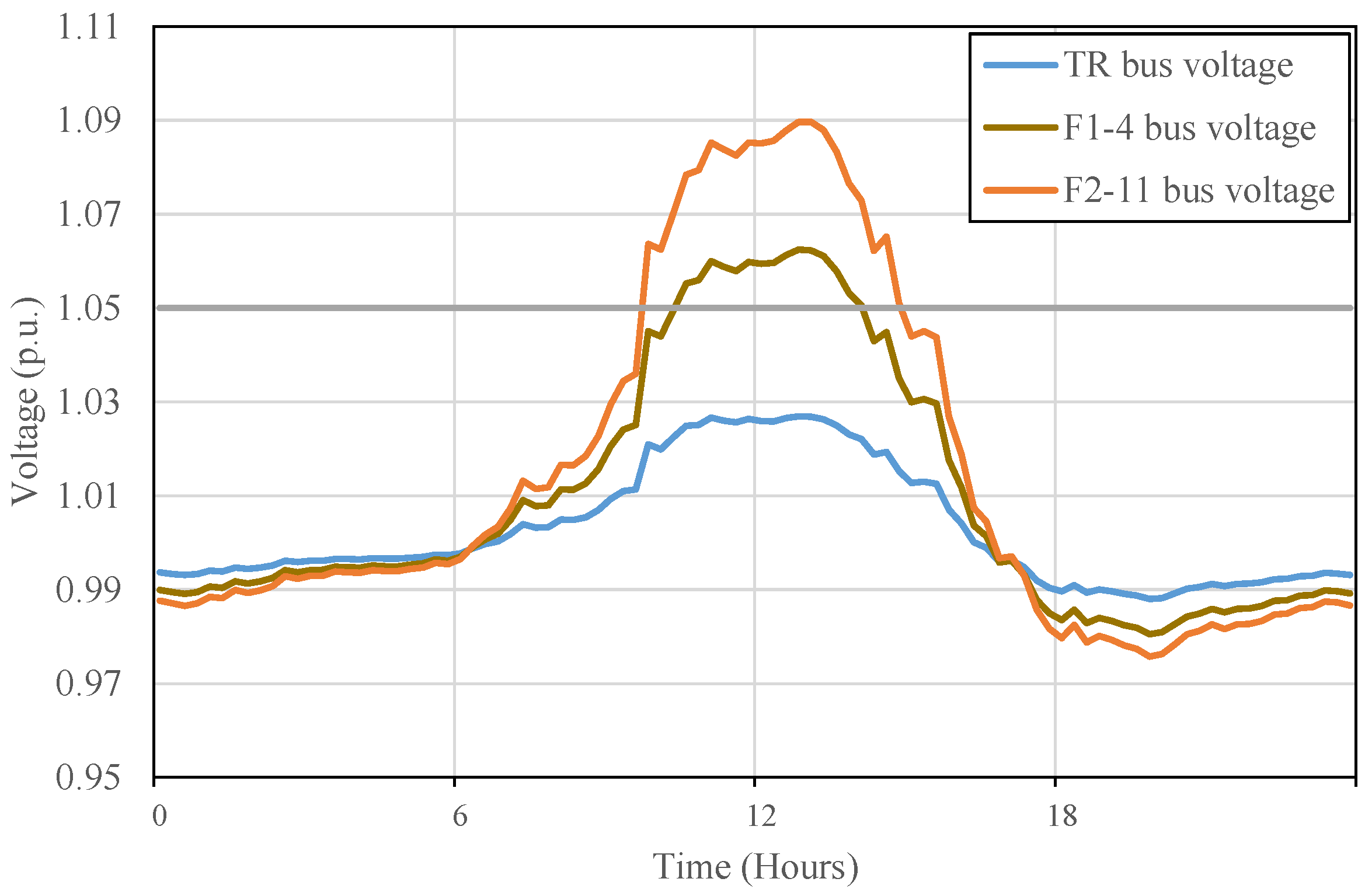
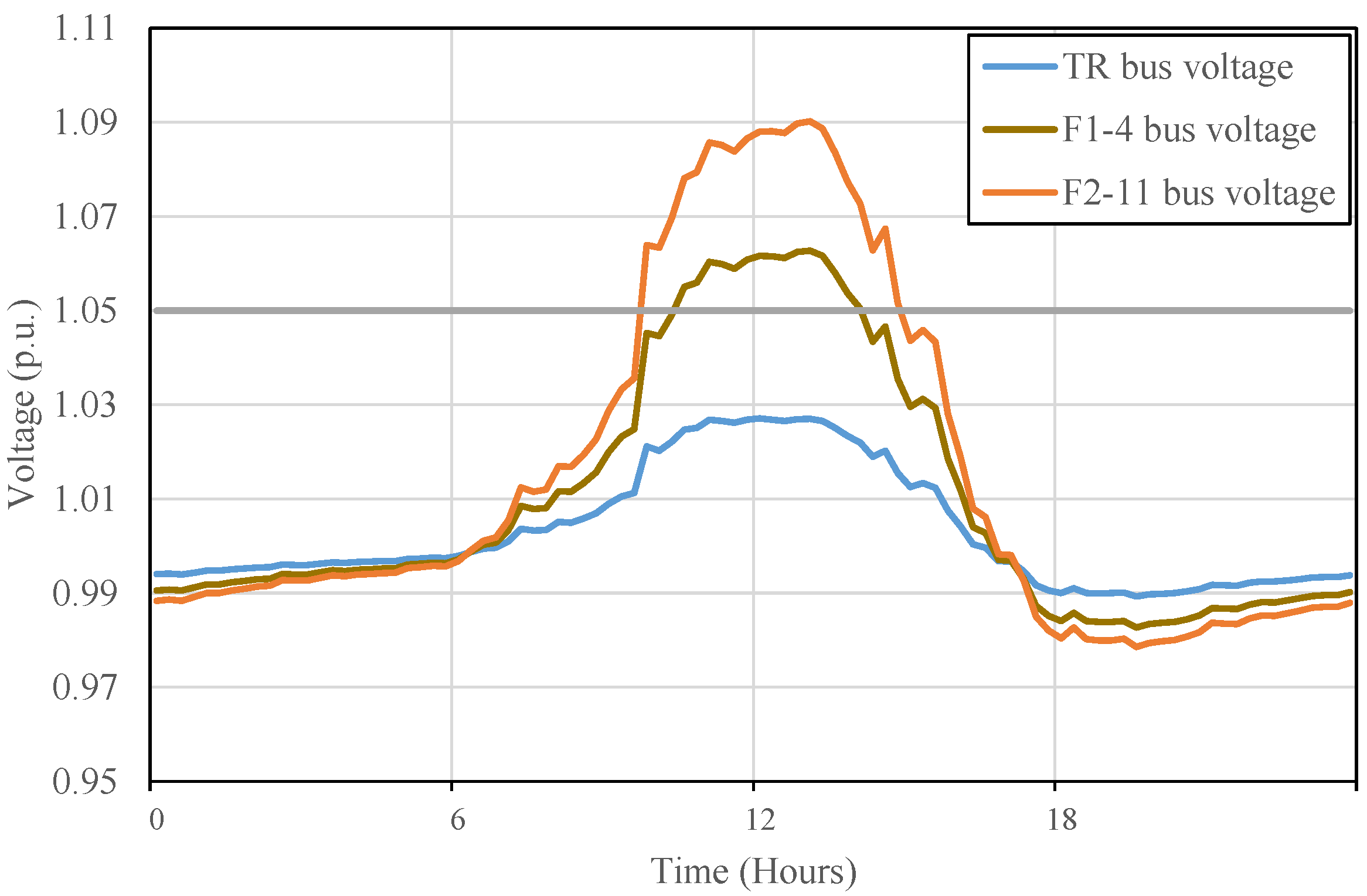
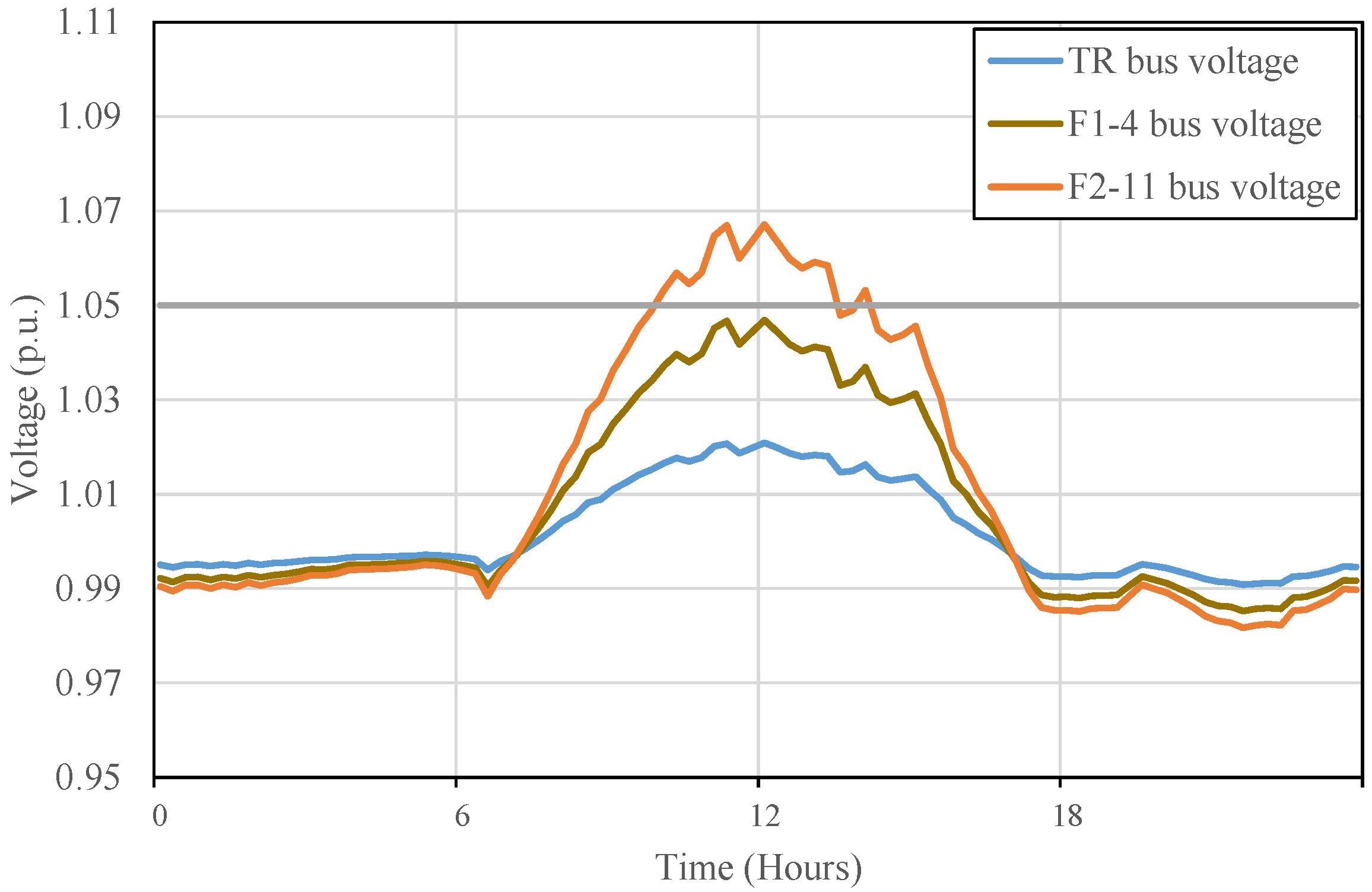

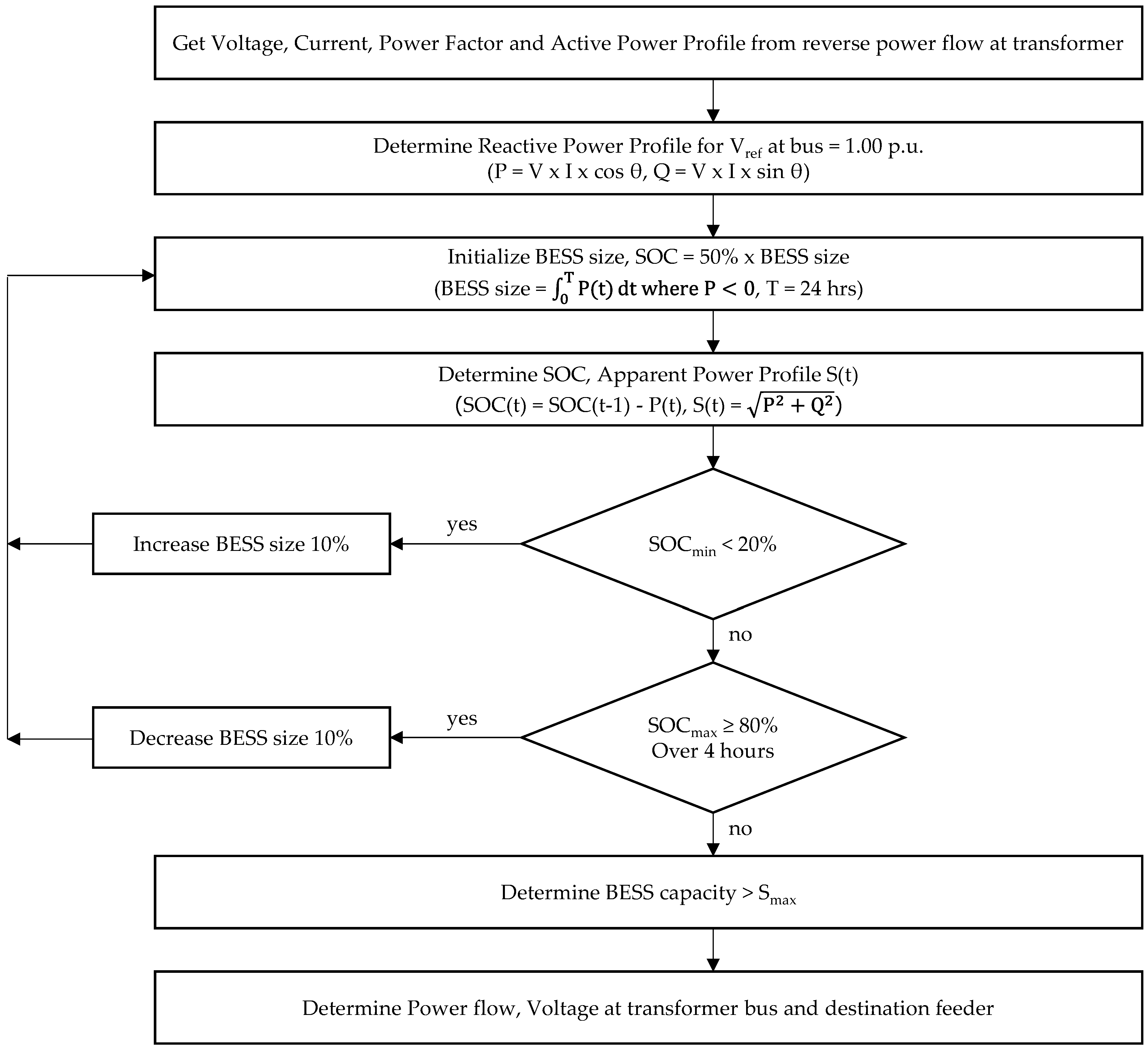
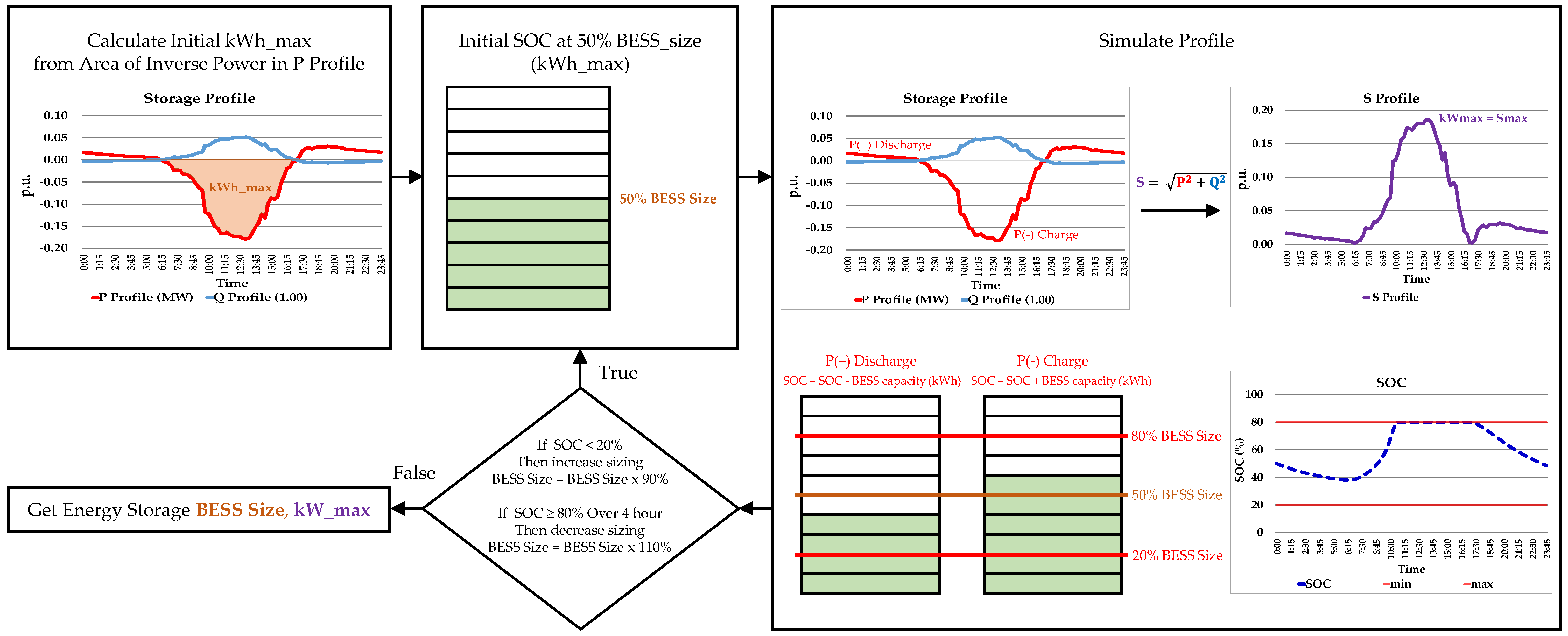
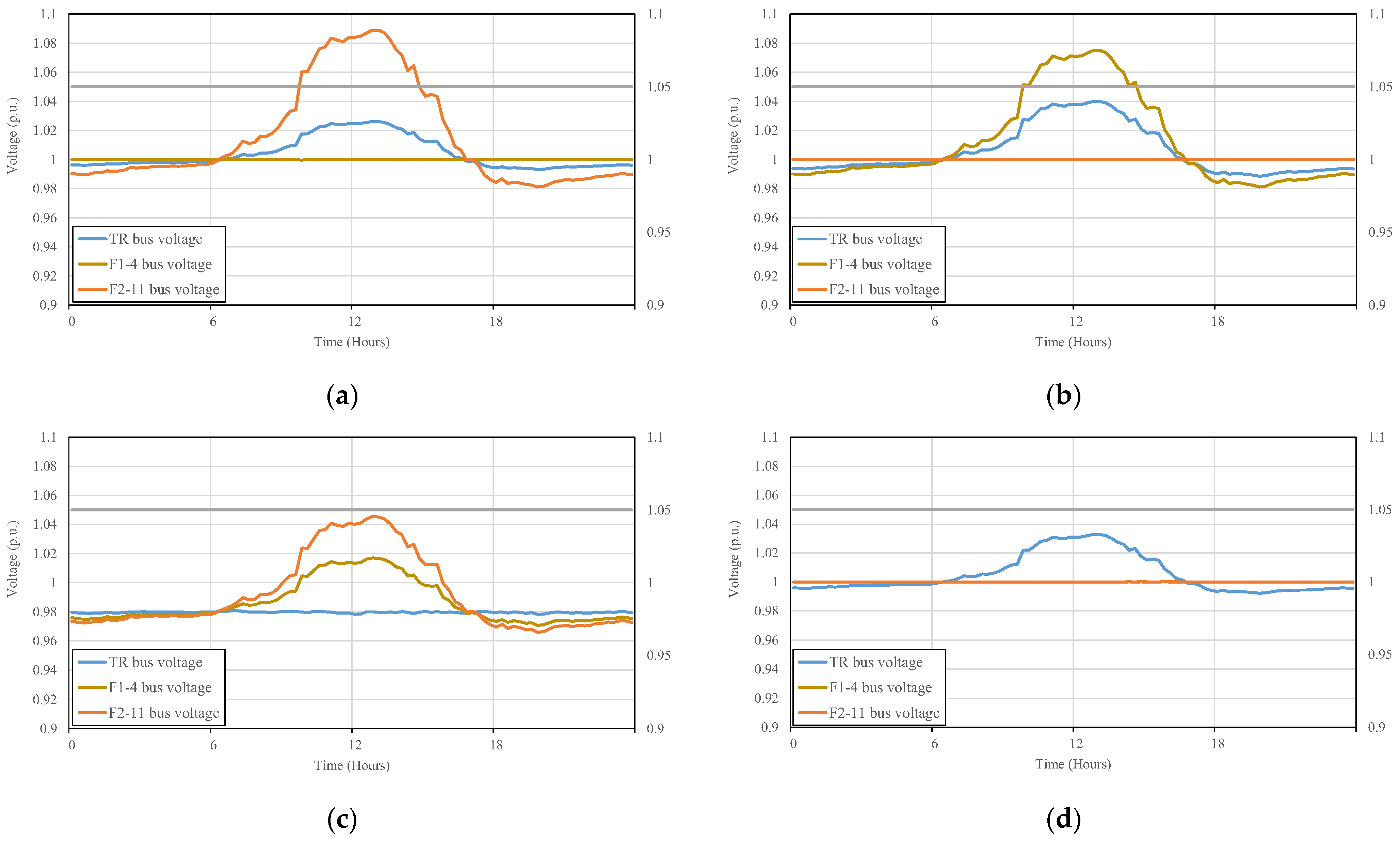
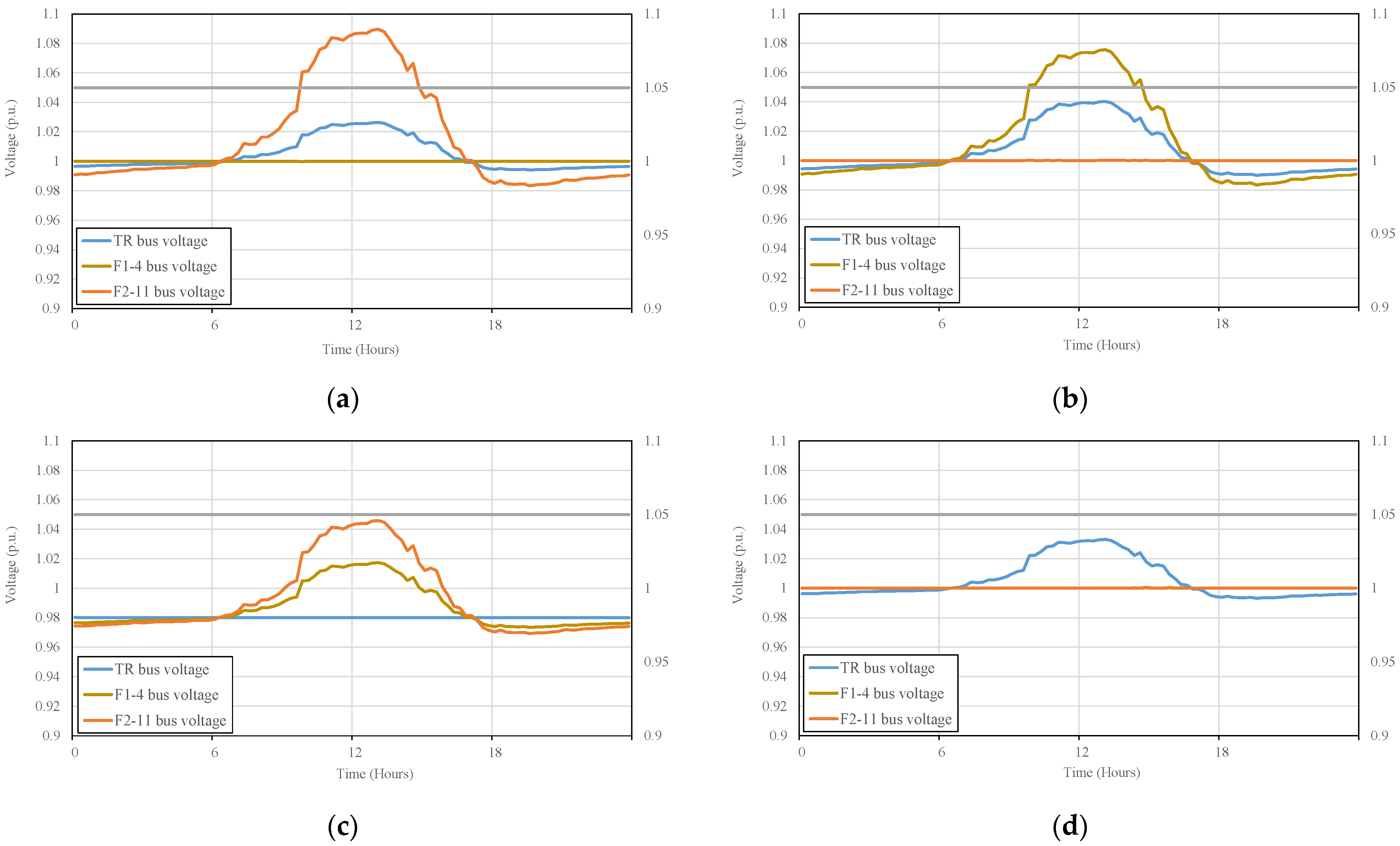


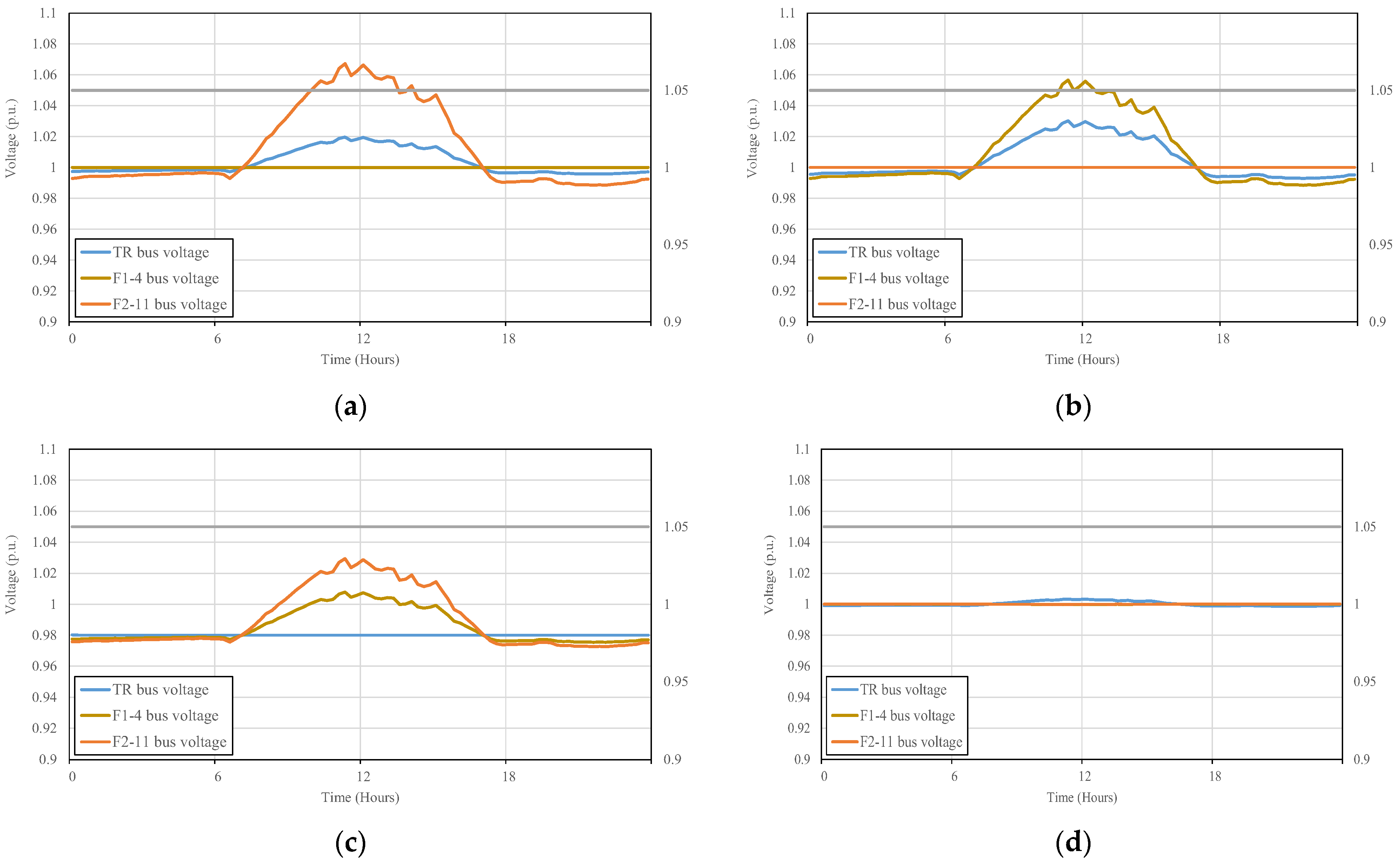
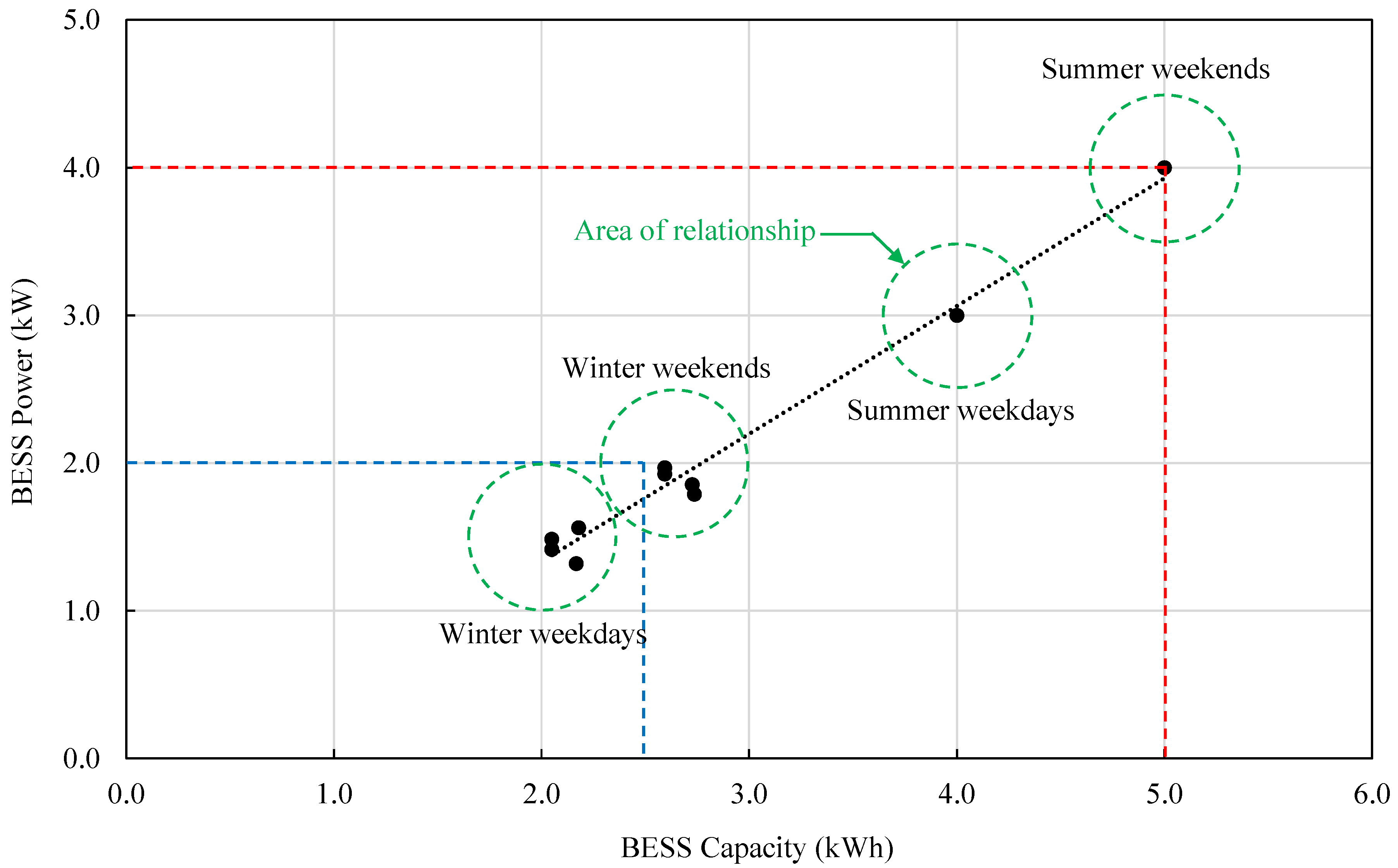
| Ref | Max PV/VRE% | Limiting Factor | Siting Concept | Method | Network Characteristics | Objectives |
|---|---|---|---|---|---|---|
| [7] | 40% of average load | Voltage | DS 1/CS 2 | Simulation: scheduling based on MILP | Radial (10 residential PV rooftop) | Increase the reliability |
| [8] | - | Voltage (1.05–0.95 p.u.) | CS | Simulation: planning framework on MINLP, MILP implemented in the mathematical language AMPL | Radial (135-node) | Power quality and economic view |
| [9] | 10–50% of load | Voltage (1.00 p.u.) | DS | Simulation: GA base bi-level and LP | Radial (IEEE 8500-Node test feeder) | Voltage regulation and economic view |
| [10] | 50–100% of load | Voltage (1.05–0.95 p.u.) | DS | Simulation: probabilistic framework on MC | Urban | Voltage regulation, power flow, phase unbalance |
| [11] | - | Voltage (1.05–0.95 p.u.) | DS | Simulation: local droop-based control with Matlab/Simulink | Radial (33 customer with 9 residential PV rooftop) | Voltage regulation |
| [12] | 0–22% of load | Voltage (1.10–1.00 p.u.) | DS/CS | Simulation: Matlab/Simulink | Radial | Voltage regulation |
| [13] | 0–130% of load | Voltage (1.10–0.95 p.u.) | CS | Simulation: GA | Radial | EMS and economic view |
| [14] | 0–70% of load | Voltage (1.06–0.94 p.u.) | CS | Simulation: DIgSILENT programming language (DPL) scripts | Radial | Voltage regulation, transformer loading and economic view |
| [15] | 0–93% of load | Voltage (1.04–0.95 p.u.) | DS | Simulation: GA performed in DIgSILENT and LP run in MATLAB | Radial (137 residential with 4 PV system) | Voltage regulation, reverse power flow and economic view |
| [16] | 30–70% of load | Voltage (1.05–0.95 p.u.) | DS | Simulation: distribution system model in MATLAB | Radial | Voltage regulation, peak shaving and economic view |
| [17] | - | Power | DS | Simulation: MATLAB | Urban | EMS and economic view |
| [18] | - | Power | CS | Field implementation | Radial | Voltage regulation, DG dispatching (energy exchange) |
| [19] | - | Voltage | DS | Simulation: SPSA method and inner algorithm, GA | Radial (IEEE unbalanced 34-bus test system) | Voltage unbalance and economic view |
| No | Distribution Transformer Parameters | Name | Rated | Vector Group | Phase | |
| 1 | Distribution Transformer 22 kV/400 V | MT3610D | 160 kVA | Dyn11 | 3 | |
| No | Feeder and Customer Details | No. Customer | Overall Length (km) | |||
| 1 | Feeder 1 | 45 | 0.7736 | |||
| 2 | Feeder 2 | 43 | 0.6513 | |||
| No | Line Parameter | Phase | Irate (kA) | Z (ohm) | R (ohm) | X (ohm) |
| 1 | UEL3 | 3 | 0.1 | 0.874 | 0.8664 | 0.1149 |
| 2 | UL3H95W | 3 | 0.235 | 0.5064 | 0.3853 | 0.3286 |
| 3 | UL3H50W | 3 | 0.153 | 0.8466 | 0.771 | 0.3498 |
| 4 | UL2H50W | 2 | 0.153 | 0.8406 | 0.7708 | 0.3353 |
| No | Component | Mode | Power Factor |
|---|---|---|---|
| 1 | Load | P, cos φ | 0.90 |
| 2 | PV inverter | P, cos φ | 0.95 |
| Scenarios | Condition | Maximum Voltage Profile Excess (p.u.) | ||
|---|---|---|---|---|
| TR Bus | End of Feeder 1 | End of Feeder 2 | ||
| 1 | Summer/Weekend | 1.0269 | 1.0625 | 1.0897 |
| 2 | Summer/Weekday | 1.0271 | 1.0628 | 1.0902 |
| 3 | Winter/Weekend | 1.0208 | 1.0469 | 1.0671 |
| 4 | Winter/Weekday | 1.0215 | 1.0483 | 1.0690 |
| Scenarios | Optimal Battery Storage Size (kWh, kW) and Location Installation | |||
|---|---|---|---|---|
| F1–4 | F2–11 | TR bus | F1–4/F2–11 | |
| 1 | 264.8 kWh, 191.9 kW | 280.4 kWh, 178.3 kW | 542.5 kWh, 407.0 kW | 264.8 kWh, 196.3 kW/ 280.4 kWh, 184.9 kW |
| 2 | 253.8 kWh, 193.0 kW | 266.7 kWh, 179.4 kW | 513.5 kWh, 407.0 kW | 253.8 kWh, 197.4 kW/ 264.8 kWh, 186.0 kW |
| 3 | 224.9 kWh, 139.8 kW | 237.4 kWh, 130.2 kW | 469.6 kWh, 302.3 kW | 224.9 kWh, 142.8 kW/ 240.4 kWh, 134.5 kW |
| 4 | 185.1 kWh, 143.4 kW | 196.0 kWh, 133.8 kW | 382.1 kWh, 310.0 kW | 185.1 kWh, 153.9 kW/ 195.3 kWh, 177.8 kW |
| Scenarios | Optimal Battery Storage Size (kWh, kW) and Location Installation | |||
|---|---|---|---|---|
| F1–4 | F2–11 | TR bus | F1–4/F2–11 | |
| 1 | 264.8 kWh, 191.9 kW | 280.4 kWh, 178.3 kW | 542.5 kWh, 407.0 kW | 264.8 kWh, 196.3 kW/ 280.4 kWh, 184.9 kW |
| 2 | 253.8 kWh, 193.0 kW | 266.7 kWh, 179.4 kW | 513.5 kWh, 407.0 kW | 253.8 kWh, 197.4 kW/ 264.8 kWh, 186.0 kW |
| Difference (%) | 4.2, 0.6 | 5.0, 0.6 | 5.5, 0.0 | 4.2, 0.6/ 5.7, 0.6 |
| Capacity (kWh) to power (kW) ratio | 2.6:1.9 | 2.7:1.8 | 5.3:4.1 | 2.6:2.0/ 2.7:1.9 |
| Scenarios | Optimal Battery Storage Size (kWh, kW) and Location Installation | |||
|---|---|---|---|---|
| F1–4 | F2–11 | TR bus | F1–4/F2–11 | |
| 3 | 224.9 kWh, 139.8 kW | 237.4 kWh, 130.2 kW | 469.6 kWh, 302.3 kW | 224.9 kWh, 142.8 kW/ 240.4 kWh, 134.5 kW |
| 4 | 185.1 kWh, 143.4 kW | 196.0 kWh, 133.8 kW | 382.1 kWh, 310.0 kW | 185.1 kWh, 153.9 kW/ 195.3 kWh, 177.8 kW |
| Difference (%) | 19.4, 2.5 | 19.1, 2.7 | 20.5, 2.5 | 19.4, 7.5/ 20.7, 27.7 |
| Capacity (kWh) to power (kW) ratio | 2.1:1.4 | 2.2:1.3 | 4.3:3.1 | 2.1:1.5/ 2.2:1.6 |
Disclaimer/Publisher’s Note: The statements, opinions and data contained in all publications are solely those of the individual author(s) and contributor(s) and not of MDPI and/or the editor(s). MDPI and/or the editor(s) disclaim responsibility for any injury to people or property resulting from any ideas, methods, instructions or products referred to in the content. |
© 2023 by the authors. Licensee MDPI, Basel, Switzerland. This article is an open access article distributed under the terms and conditions of the Creative Commons Attribution (CC BY) license (https://creativecommons.org/licenses/by/4.0/).
Share and Cite
Kitworawut, P.; Ketjoy, N.; Suriwong, T.; Kaewpanha, M. Best Practice in Battery Energy Storage for Photovoltaic Systems in Low Voltage Distribution Network: A Case Study of Thailand Provincial Electricity Authority Network. Energies 2023, 16, 2469. https://doi.org/10.3390/en16052469
Kitworawut P, Ketjoy N, Suriwong T, Kaewpanha M. Best Practice in Battery Energy Storage for Photovoltaic Systems in Low Voltage Distribution Network: A Case Study of Thailand Provincial Electricity Authority Network. Energies. 2023; 16(5):2469. https://doi.org/10.3390/en16052469
Chicago/Turabian StyleKitworawut, Pairach, Nipon Ketjoy, Tawat Suriwong, and Malinee Kaewpanha. 2023. "Best Practice in Battery Energy Storage for Photovoltaic Systems in Low Voltage Distribution Network: A Case Study of Thailand Provincial Electricity Authority Network" Energies 16, no. 5: 2469. https://doi.org/10.3390/en16052469
APA StyleKitworawut, P., Ketjoy, N., Suriwong, T., & Kaewpanha, M. (2023). Best Practice in Battery Energy Storage for Photovoltaic Systems in Low Voltage Distribution Network: A Case Study of Thailand Provincial Electricity Authority Network. Energies, 16(5), 2469. https://doi.org/10.3390/en16052469







